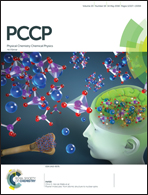Insight into the mechanism of methanol assistance with syngas conversion over partially hydroxylated γ-Al2O3(110D) surface in slurry bed†
Abstract
Despite numerous studies devoted to the various properties of γ-Al2O3, the explorations of its catalytic activity remain scarce. In this study, density functional theory calculations are performed to study the elementary adsorption and reaction mechanisms for syngas conversion on partially hydroxylated γ-Al2O3(110D) surface in liquid paraffin. It is found that the partially hydroxylated γ-Al2O3(110D) surface with the hydroxyl coverage of 8.9 OH nm−2 is formed by two dissociative adsorptions of H2O on the dry γ-Al2O3(110D) surface. The hydroxyl coverage conditions play a key role in determining the dominant reaction mechanism on account of the existence of strong hydrogen bonds. The preferential pathway for syngas conversion with assistance of methanol over the partially hydroxylated γ-Al2O3(110D) surface in liquid paraffin has been proven to be CH3OH → CH3O + H → CH3 + OH, CH3 + CO → CH3CO. C2H5OH is then formed by successive hydrogenation via the pathway CH3CO + 3H → CH3CHO + 2H → CH3CH2O + H → C2H5OH. Here, CH3CHO formation by CH3CO hydrogenation is not inhibited. Actually, with the assistance of partially hydroxylated γ-Al2O3, CH3CHO has been synthesized with high selectivity in our previous experiment by the reaction of methanol and syngas, which provides favorable evidence for our results. The rate-limiting step is the formation of CH3O from CH3OH dehydrogenation with an activation barrier of 122.2 kJ mol−1. Moreover, the reaction barrier of CO insertion into the adsorbed CH3 group is at least 89.4 kJ mol−1, lower than those of CH4, C2H6, and CH3OCH3 formations. ADCH charge and ESP analyses indicate that the typical (Al, O) Lewis acid–base pair may have a significant effect upon the initial C–C chain formation. Thus, the present study provides a new approach for the rational tailoring and designing of new catalysts with superior reactivity involved in syngas conversion.



 Please wait while we load your content...
Please wait while we load your content...